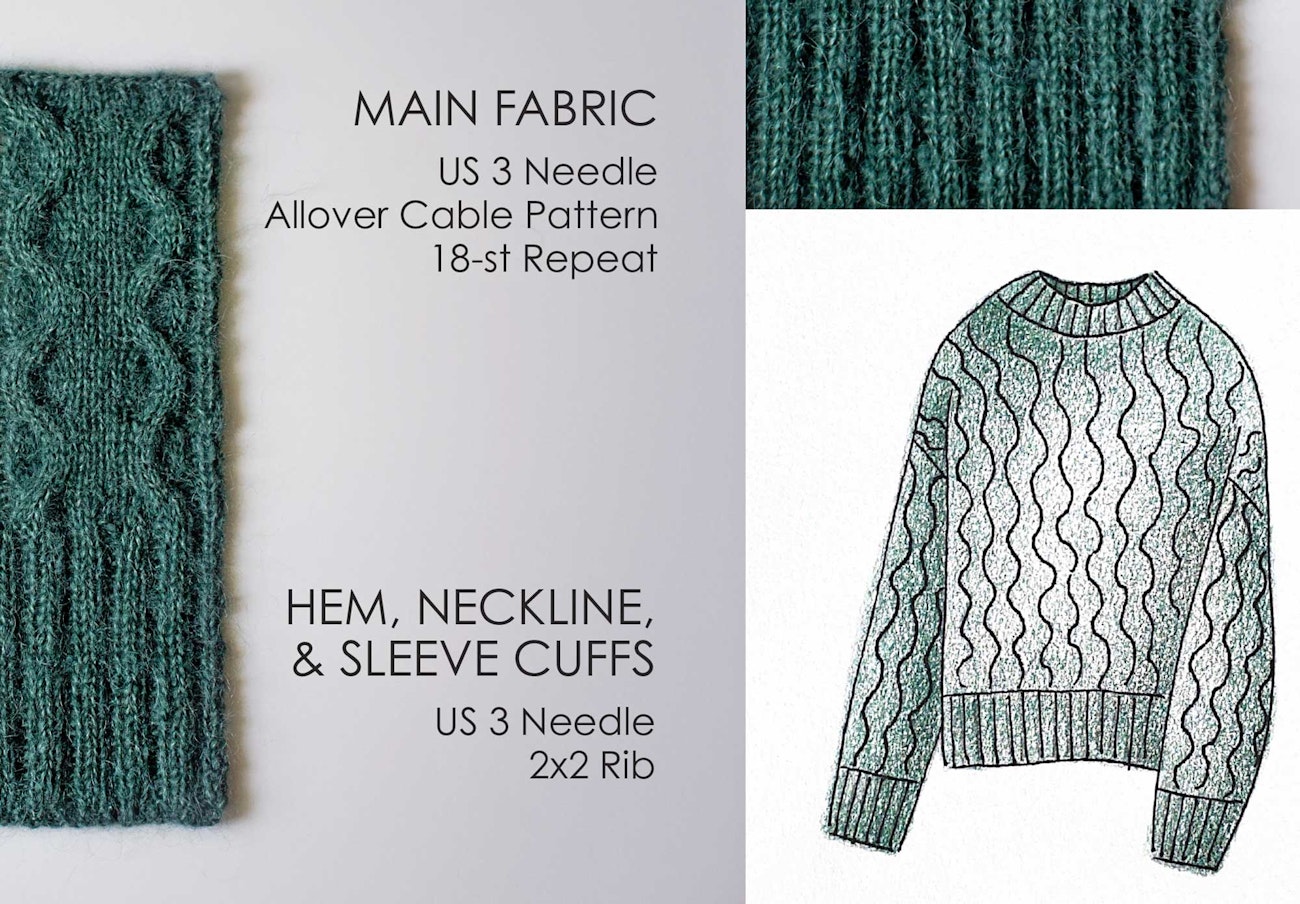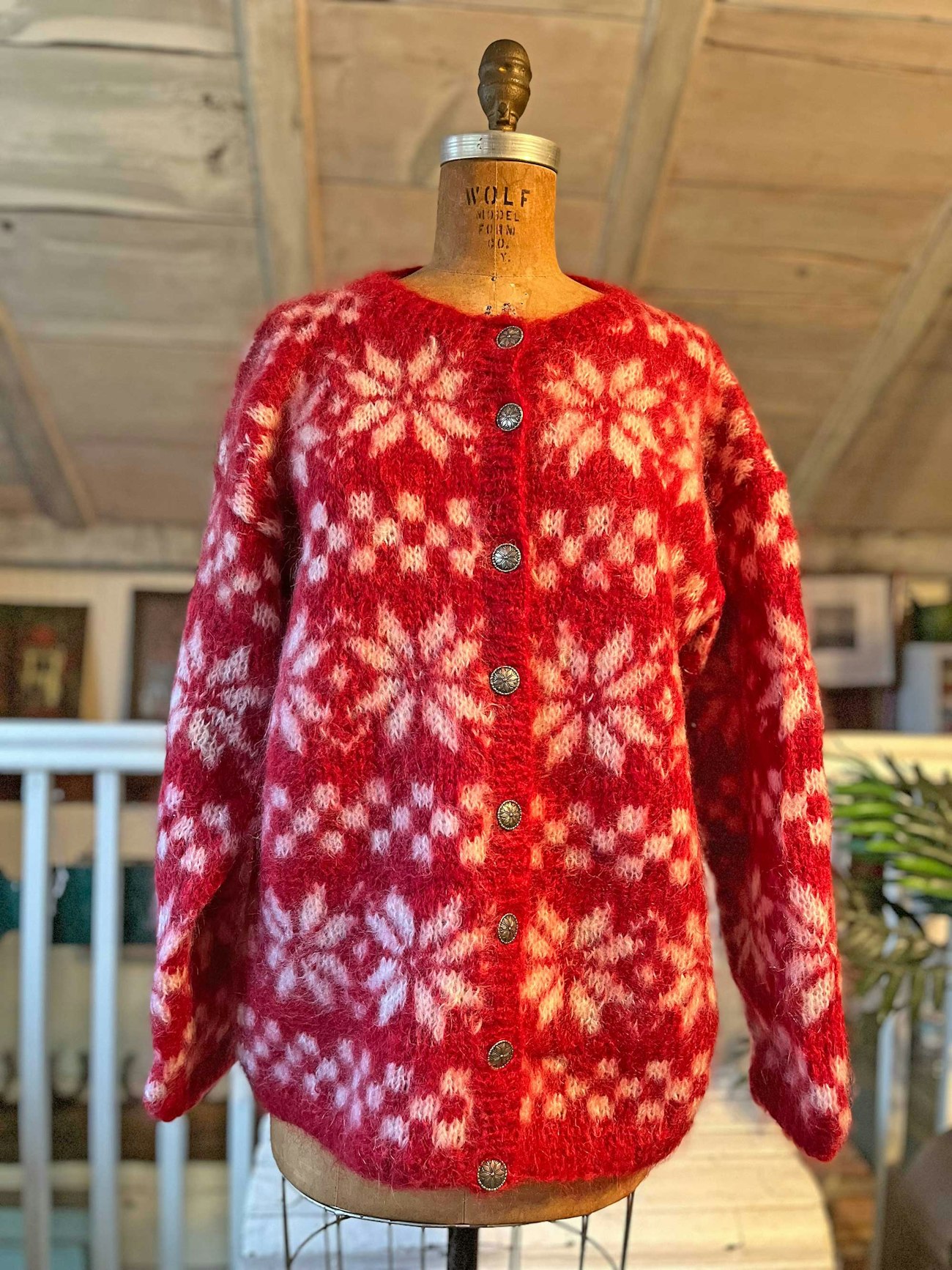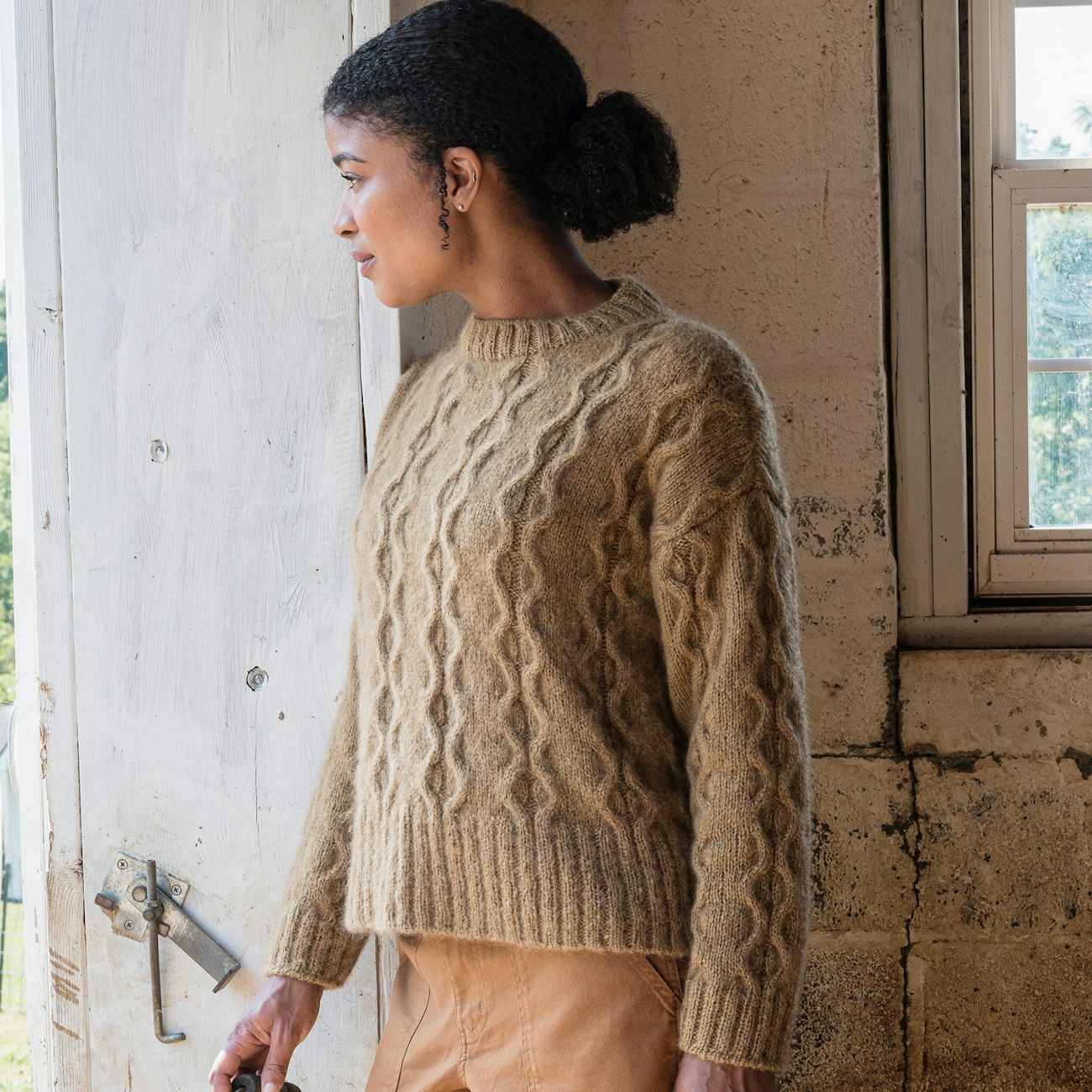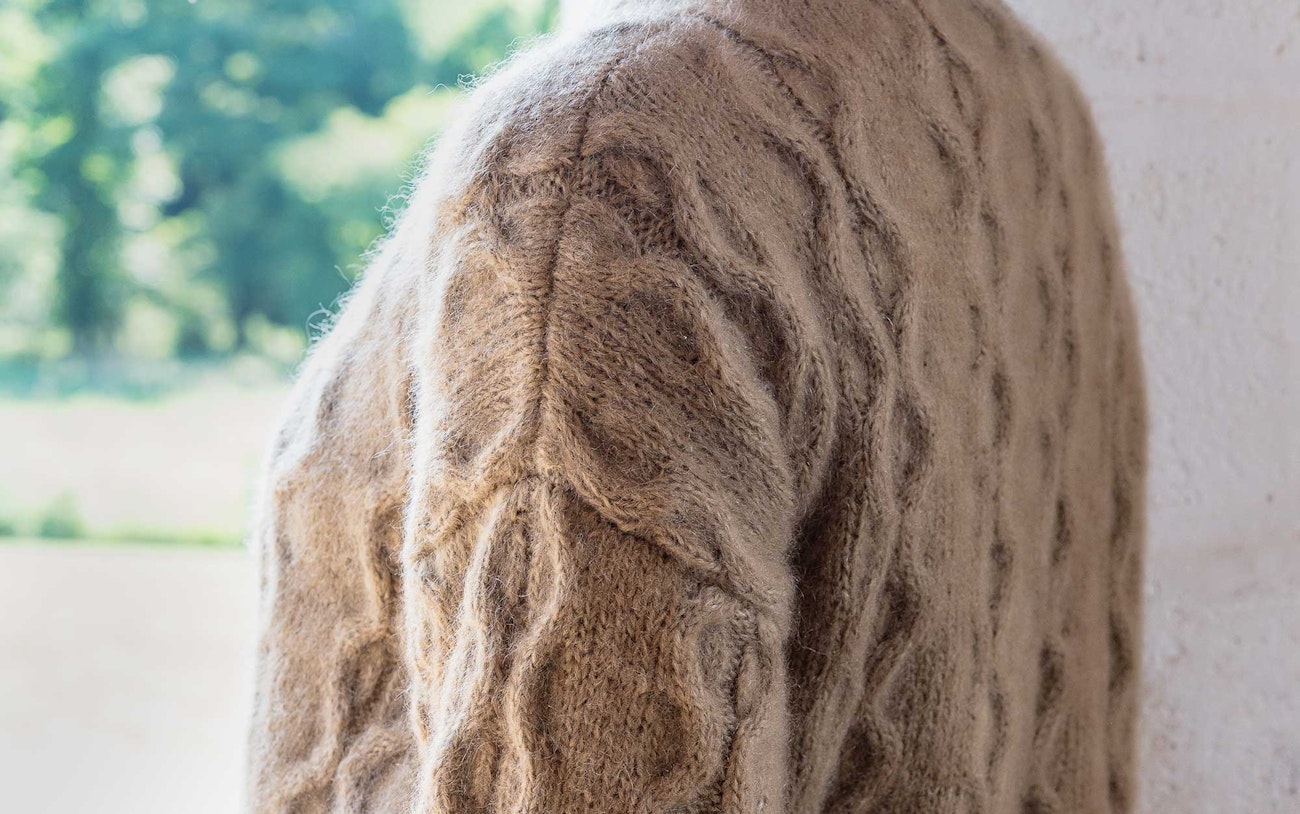Subscriber Exclusive
Make Mine Mohair
Knitters have long had a love-hate relationship with the fluffy fiber of the Angora goat. Why is mohair yarn having a moment now?
Knitters have long had a love-hate relationship with the fluffy fiber of the Angora goat. Why is mohair yarn having a moment now? <a href="https://farmfiberknits.com/make-mine-mohair/">Continue reading.</a>
https://farmfiberknits.com/cdn-cgi/image/format=auto/https://www.datocms-assets.com/101500/1734669666-mohair-swatch.jpg?auto=format&w=900
When Tayler Harris’s design proposal for a cabled mohair pullover came into the Farm & Fiber Knits submissions inbox, the editorial team just knew it was a winner. A classic silhouette swatched up in a luscious yarn, Tayler’s sweater checked all the boxes for a Farm & Fiber pattern: inspired by the natural world; fun-to-knit with a touch of challenge; a timeless style that will look as good in 10 years as it does today; gradable for a range of sizes; and knit in a yarn with a story.
 Part of Tayler Harris’s proposal, which became the Rakaia Pullover. Sketch and photos by Tayler Harris
Part of Tayler Harris’s proposal, which became the Rakaia Pullover. Sketch and photos by Tayler Harris
Mohair yarn, both for handknitting and high fashion, has gone in and out of favor numerous times over the years. Known as a luxury or noble fiber, mohair is shorn from the long silky coat of the Angora goat. The word Angora stems from Ankara, the Turkish region the goats originated from, and according to the Encyclopedia Britannica, the word “mohair” is derived from the Arabic mukhayyar. Today around 50% of mohair fiber is produced in South Africa, and Texas is the mohair capital of the United States. (Note: Angora rabbits are the source of “Angora fiber”—those fluffy bunnies came from the same region as the goats and also produce soft, long-staple fiber. But that’s another story.)
My first recollection of mohair for handknitting was in the 1960s, when the preppy older girls were learning to knit so they could make the bulky brushed mohair sweaters that were popular at the time. My across-the-street neighbor owned a yarn shop, so I had an inside track on knitting trends. I knitted my first scarf with mohair but was frustrated by how hard it was to rip out, and I gave up. I did jump on the next wave of mohair knitting in the late 80s/early 90s, when designers like Perry Ellis and Adrienne Vittadini were cranking out trendy oversized mohair handknits. I recently brought my two-color mohair snowflake cardigan back into circulation. (Note: It's even harder to rip out mohair when you are working with two colors.)
 The author’s knitted mohair cardigan. Photo by Karin Strom
The author’s knitted mohair cardigan. Photo by Karin Strom
Mohair fiber has long been used to add softness to wool blend yarns, but the last few years have seen another resurgence in interest for the luscious, primarily mohair yarns being produced today. What is the appeal? I asked Kristin Nicholas, who was the Creative Director at Classic Elite Yarns during the heyday of their popular La Gran Mohair. “I'm so happy to see a renewed interest in mohair,” she shared. “I have always been a fan—even when it’s out of fashion.”
Kristin explains, “Mohair fiber is smooth, unlike wool, which has microscopic scales on each fiber. This makes mohair an extremely lustrous fiber that reflects light. That shine is what makes mohair so gorgeous when it’s dyed. For me, the most remarkable thing about the fiber is the richness of color that you can get when it’s dyed.” La Gran was available in a rainbow palette of over 70 vibrant shades.
Often blended with silk, today’s mohair yarns continue that tradition of soft, luxurious yarns with
SUBSCRIBER EXCLUSIVE
When Tayler Harris’s design proposal for a cabled mohair pullover came into the Farm & Fiber Knits submissions inbox, the editorial team just knew it was a winner. A classic silhouette swatched up in a luscious yarn, Tayler’s sweater checked all the boxes for a Farm & Fiber pattern: inspired by the natural world; fun-to-knit with a touch of challenge; a timeless style that will look as good in 10 years as it does today; gradable for a range of sizes; and knit in a yarn with a story.
 Part of Tayler Harris’s proposal, which became the Rakaia Pullover. Sketch and photos by Tayler Harris
Part of Tayler Harris’s proposal, which became the Rakaia Pullover. Sketch and photos by Tayler Harris
Mohair yarn, both for handknitting and high fashion, has gone in and out of favor numerous times over the years. Known as a luxury or noble fiber, mohair is shorn from the long silky coat of the Angora goat. The word Angora stems from Ankara, the Turkish region the goats originated from, and according to the Encyclopedia Britannica, the word “mohair” is derived from the Arabic mukhayyar. Today around 50% of mohair fiber is produced in South Africa, and Texas is the mohair capital of the United States. (Note: Angora rabbits are the source of “Angora fiber”—those fluffy bunnies came from the same region as the goats and also produce soft, long-staple fiber. But that’s another story.)
My first recollection of mohair for handknitting was in the 1960s, when the preppy older girls were learning to knit so they could make the bulky brushed mohair sweaters that were popular at the time. My across-the-street neighbor owned a yarn shop, so I had an inside track on knitting trends. I knitted my first scarf with mohair but was frustrated by how hard it was to rip out, and I gave up. I did jump on the next wave of mohair knitting in the late 80s/early 90s, when designers like Perry Ellis and Adrienne Vittadini were cranking out trendy oversized mohair handknits. I recently brought my two-color mohair snowflake cardigan back into circulation. (Note: It's even harder to rip out mohair when you are working with two colors.)
 The author’s knitted mohair cardigan. Photo by Karin Strom
The author’s knitted mohair cardigan. Photo by Karin Strom
Mohair fiber has long been used to add softness to wool blend yarns, but the last few years have seen another resurgence in interest for the luscious, primarily mohair yarns being produced today. What is the appeal? I asked Kristin Nicholas, who was the Creative Director at Classic Elite Yarns during the heyday of their popular La Gran Mohair. “I'm so happy to see a renewed interest in mohair,” she shared. “I have always been a fan—even when it’s out of fashion.”
Kristin explains, “Mohair fiber is smooth, unlike wool, which has microscopic scales on each fiber. This makes mohair an extremely lustrous fiber that reflects light. That shine is what makes mohair so gorgeous when it’s dyed. For me, the most remarkable thing about the fiber is the richness of color that you can get when it’s dyed.” La Gran was available in a rainbow palette of over 70 vibrant shades.
Often blended with silk, today’s mohair yarns continue that tradition of soft, luxurious yarns with[PAYWALL] saturated palettes, which both fashion and handknitting designers are responding to. For Tayler’s design, we looked at several yarn options but went with the one she had swatched in, Biches & Bûches Le Gros Silk & Mohair (28% mulberry silk, 72% super kid mohair; 162 yd/ 50 g; DK weight). Biches & Bûches is a small company, located in the Burgundy region of France, that offers a tightly curated selection of natural-fiber yarns and lovely patterns.
 Tayler’s beautifully soft sweater was inspired by the flow of the water as rivers carve and shape the landscape around them. Photo by Gale Zucker
Tayler’s beautifully soft sweater was inspired by the flow of the water as rivers carve and shape the landscape around them. Photo by Gale Zucker
“I’m glad we went with the original yarn choice,” Tayler says. “It felt like the perfect fit for this sweater from the start. I chose it because it really captures the essence of the design. The softness and beautiful halo effect bring out the fluidity of the cables, while the unique texture sets it apart from other mohair yarns, giving the sweater an elevated, distinctive look.”
Tayler’s inspiration for this design was the beauty of rivers. “The flow of the water as it carves and shapes the landscape around it, the strength of the currents, and the importance rivers carry for our ecosystem. Just as the land can be sculpted by the flow of a river over time, the soft cables of this sweater slowly take shape and reveal beautiful bends and gentle valleys. The simplicity in the knitting makes for a meditative, calm knit, and reminds me of the way a river tears away rock and soil along its bed.”
“I was pleasantly surprised by how quickly this piece knit up,” she adds. “The yarn felt so lovely in my hands throughout the process. It added so much to the experience of creating the sweater, and I think it helped bring the inspiration to life.”
 Knitting with mohair delivers a lovely halo effect to the surface texture of the garment. Photo by Gale Zucker
Knitting with mohair delivers a lovely halo effect to the surface texture of the garment. Photo by Gale Zucker
Kristin Nicholas is still wearing La Gran sweaters she made thirty years ago. “People come up to me and touch my arm because the yarn is so soft. It’s the halo created by the brushed yarn that says, ‘Hug me!’” Her main complaint? “A mohair sweater can have the illusion of adding pounds to its wearer.” One way to avoid this is to, "Knit scarves, hats, or mittens!” Or you can look for garments that are designed with the halo and drape of mohair in mind, like the Rakaia Pullover.
Tayler has no complaints. “I really love working with mohair. One of the biggest pros is the resulting fabric—the softness, the halo, and the unique texture create a look you just can’t achieve with any other yarn. While it can sometimes be frustrating if you need to unravel or fix mistakes, I found that wasn’t an issue with this particular yarn. I think that’s because it’s a bit heavier than lace-weight mohair I’m used to, which made it much easier to handle and more forgiving during the knitting process.”
She hopes knitting this sweater brings joy to those who make it. “I also hope it offers some calm and meditative moments throughout the process and that this sense of flow carries over into their lives when they wear it.”
 Part of Tayler Harris’s proposal, which became the Rakaia Pullover. Sketch and photos by Tayler Harris
Part of Tayler Harris’s proposal, which became the Rakaia Pullover. Sketch and photos by Tayler Harris  The author’s knitted mohair cardigan. Photo by Karin Strom
The author’s knitted mohair cardigan. Photo by Karin Strom 

 Tayler’s beautifully soft sweater was inspired by the flow of the water as rivers carve and shape the landscape around them. Photo by Gale Zucker
Tayler’s beautifully soft sweater was inspired by the flow of the water as rivers carve and shape the landscape around them. Photo by Gale Zucker  Knitting with mohair delivers a lovely halo effect to the surface texture of the garment. Photo by Gale Zucker
Knitting with mohair delivers a lovely halo effect to the surface texture of the garment. Photo by Gale Zucker